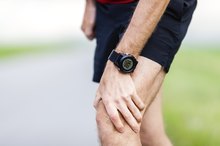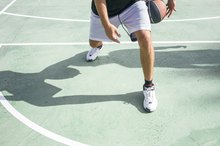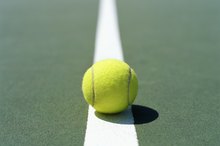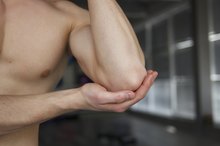Knee Pain From Kicking a Ball
Whether you play soccer as a hobby or on a community team, the repetitive motions from running and kicking can wreak havoc on the muscles and tendons in your knee. The pain you feel when kicking the ball can have a variety of causes, all due to overuse or strain in the knee muscles. By understanding the cause of your knee pain, you'll know better how to treat the pain and adjust your skills to avoid knee pain in the future.
If you are experiencing serious medical symptoms, seek emergency treatment immediately.
Causes
Since the pain in your knee when kicking a ball can have a variety of causes, it's best to check with your doctor if you have ongoing or lingering issues. Some of the causes of knee pain include an anterior cruciate ligament tear, attributed to sudden changes in the joint's direction. Patellar tendinitis may affect soccer players who play often and suffer from pain due to repeated overuse of the knee. Your knee pain could be attributed to patellofemoral joint syndrome, a condition where the kneecap doesn't glide over the femur efficiently and results in locking and pain.
- Since the pain in your knee when kicking a ball can have a variety of causes, it's best to check with your doctor if you have ongoing or lingering issues.
- Your knee pain could be attributed to patellofemoral joint syndrome, a condition where the kneecap doesn't glide over the femur efficiently and results in locking and pain.
Symptoms
Pain Above the Knee Cap With Running
Learn More
Depending on the cause of your pain, you may experience it in different ways. If your pain is the result of an ACL tear, you'll feel a sharp pain when you go to kick the ball and that pain will not subside until you rest your knee. When patellar tendinitis results in knee pain, you'll feel a constant throbbing or numbing sensation just below the kneecap. If atellofemoral joint syndrome is the culprit, you may experience pain on either side of your knee, along with a locking sensation when you extend your knee to make a kick.
- Depending on the cause of your pain, you may experience it in different ways.
- When patellar tendinitis results in knee pain, you'll feel a constant throbbing or numbing sensation just below the kneecap.
Treatment
In most cases, the best treatment for knee pain is using the rest, ice, compression and elevation (R.I.C.E.) formula. Knee pain is greatly alleviated by rest, especially when it's the result of an ACL tear or patellar tendinitis. Inflammation and tears can be reduced and healed through proper rest of the knee. Playing while in pain could exacerbate your symptoms or cause long-term damage. Patellofemoral joint syndrome is usually treated through a combination of physical therapy and bracing the knee 1. However, in some cases surgery is required to reduce the amount of lateral pull on the knee joint.
- In most cases, the best treatment for knee pain is using the rest, ice, compression and elevation (R.I.C.E.)
- formula.
- Patellofemoral joint syndrome is usually treated through a combination of physical therapy and bracing the knee 1.
Prevention
Right Elbow Pain When Playing Golf
Learn More
When it comes to knee pain, prevention is the best medicine. Practicing your kicking technique can help you avoid strain injuries. When you kick the ball, your knee should never snap for the most power. Instead of kicking with your toe, cushion the ball against the inside of your foot to protect your knee. When you kick, keep your knee soft. Avoid repetitive use injuries by giving your knee sufficient rest after a practice or game. When you start to feel pain, stop playing and visit your doctor to get treatment before the condition becomes worse.
- When it comes to knee pain, prevention is the best medicine.
- When you kick the ball, your knee should never snap for the most power.
Related Articles
References
- American Academy of Family Physicians; Patellofemoral Pain Syndrome: A Review and Guidelines for Treatment; Mark S. Juhn; Nov. 1999
- American Academy of Orthopaedic Surgeons; Runner's Knee (Patellofemoral Pain); Aug. 2007
- American Academy of Orthopaedic Surgeons; Adolescent Anterior Knee Pain; June 2010
- Lespasio MJ, Piuzzi NS, Husni ME, Muschler GF, Guarino A, Mont MA. Knee Osteoarthritis: A Primer. Perm J. 2017;21:16-183. doi:10.7812/TPP/16-183
- Kiapour AM, Murray MM. Basic science of anterior cruciate ligament injury and repair. Bone Joint Res. 2014;3(2):20-31. doi:10.1302/2046-3758.32.2000241
- Doral MN, Bilge O, Huri G, Turhan E, Verdonk R. Modern treatment of meniscal tears. EFORT Open Rev. 2018;3(5):260-268. doi:10.1302/2058-5241.3.170067
- Reinking MF. CURRENT CONCEPTS IN THE TREATMENT OF PATELLAR TENDINOPATHY. Int J Sports Phys Ther. 2016;11(6):854-866.
- Petersen W, Rembitzki I, Liebau C. Patellofemoral pain in athletes. Open Access J Sports Med. 2017;8:143-154. doi:10.2147/OAJSM.S133406
- Frush TJ, Noyes FR. Baker's Cyst: Diagnostic and Surgical Considerations. Sports Health. 2015;7(4):359-65. doi:10.1177/1941738113520130
- Huang YC, Yeh WL. Endoscopic treatment of prepatellar bursitis. Int Orthop. 2011;35(3):355-8. doi:10.1007/s00264-010-1033-5
- Beals C, Flanigan D. A Review of Treatments for Iliotibial Band Syndrome in the Athletic Population. J Sports Med (Hindawi Publ Corp). 2013;2013:367169. doi:10.1155/2013/367169
- Tsai CH, Hsu CJ, Hung CH, Hsu HC. Primary traumatic patellar dislocation. J Orthop Surg Res. 2012;7:21. doi:10.1186/1749-799X-7-21
- Ragab G, Elshahaly M, Bardin T. Gout: An old disease in new perspective - A review. J Adv Res. 2017;8(5):495-511. doi:10.1016/j.jare.2017.04.008
- Lee PYF, Nixion A, Chandratreya A, Murray JM. Synovial Plica Syndrome of the Knee: A Commonly Overlooked Cause of Anterior Knee Pain. Surg J (N Y). 2017;3(1):e9-e16. doi:10.1055/s-0037-1598047
- Vaishya R, Azizi AT, Agarwal AK, Vijay V. Apophysitis of the Tibial Tuberosity (Osgood-Schlatter Disease): A Review. Cureus. 2016;8(9):e780. doi:10.7759/cureus.780
- Zanon G, Di vico G, Marullo M. Osteochondritis dissecans of the knee. Joints. 2014;2(1):29-36.
- Hindle P, Davidson E, Biant LC. Septic arthritis of the knee: the use and effect of antibiotics prior to diagnostic aspiration. Ann R Coll Surg Engl. 2012;94(5):351-5. doi:10.1308/003588412X13171221591015
- Gwinner C, Märdian S, Schwabe P, Schaser KD, Krapohl BD, Jung TM. Current concepts review: Fractures of the patella. GMS Interdiscip Plast Reconstr Surg DGPW. 2016;5:Doc01. doi:10.3205/iprs000080
- Voskuil R, Evenski AJ, Montgomery C, Emory CL. Malignant Bone Tumors of the Knee: How to Identify and Treat. J Knee Surg. 2019;32(4):305-314. doi:10.1055/s-0038-1675828
- Gupte C, St mart JP. The acute swollen knee: diagnosis and management. J R Soc Med. 2013;106(7):259-68. doi:10.1177/0141076813482831
- American Academy of Orthopedic Surgeons. Unstable Kneecap.
- Bhatia D, Bejarano T, Novo M. Current interventions in the management of knee osteoarthritis. Journal of Pharmacy & Bioallied Sciences 2013 Jan-Mar;5(1):30-38. doi:%2010.4103/0975-7406.106561
- Bronstein RD, Schaffer JC. Physical Examination of the Knee: Meniscus, Cartilage, and Patellofemoral Conditions. J Am Acad Orthop Surg. 2017 May;25(5):365-374.
- Browne K, Kurtz CA. How to perform a comprehensive examination of the knee. JAAPA. 2009 Jun;22(6):20-25.
- Hergenroeder AC, Harvey BS. (2017). Osteochondritis dissecans (OCD): Clinical manifestations and diagnosis. Bachur RG, ed. UpToDate. Waltham, MA: UpToDate Inc.
Writer Bio
Kay Ireland specializes in health, fitness and lifestyle topics. She is a support worker in the neonatal intensive care and antepartum units of her local hospital and recently became a certified group fitness instructor.








